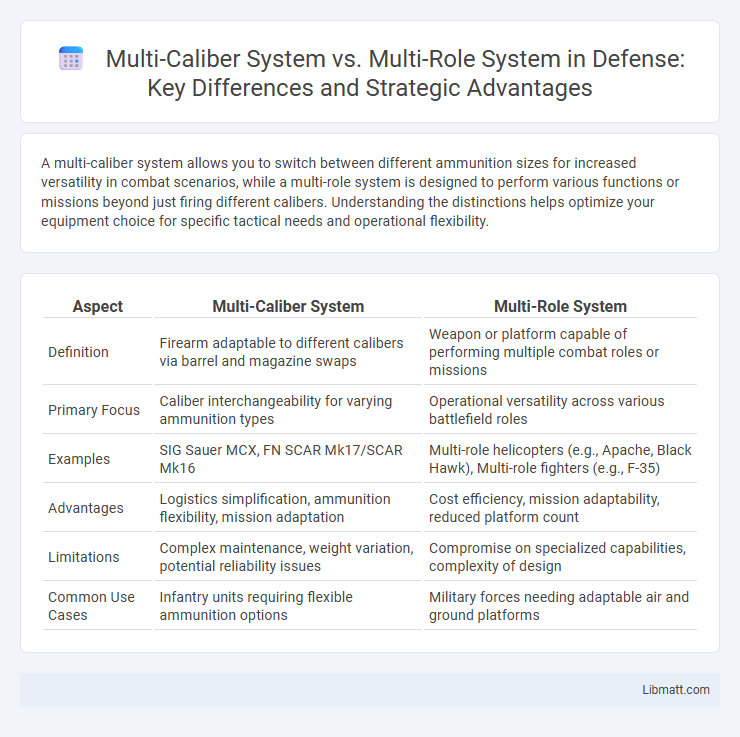A multi-caliber system allows you to switch between different ammunition sizes for increased versatility in combat scenarios, while a multi-role system is designed to perform various functions or missions beyond just firing different calibers. Understanding the distinctions helps optimize your equipment choice for specific tactical needs and operational flexibility.
Table of Comparison
| Aspect | Multi-Caliber System | Multi-Role System |
|---|---|---|
| Definition | Firearm adaptable to different calibers via barrel and magazine swaps | Weapon or platform capable of performing multiple combat roles or missions |
| Primary Focus | Caliber interchangeability for varying ammunition types | Operational versatility across various battlefield roles |
| Examples | SIG Sauer MCX, FN SCAR Mk17/SCAR Mk16 | Multi-role helicopters (e.g., Apache, Black Hawk), Multi-role fighters (e.g., F-35) |
| Advantages | Logistics simplification, ammunition flexibility, mission adaptation | Cost efficiency, mission adaptability, reduced platform count |
| Limitations | Complex maintenance, weight variation, potential reliability issues | Compromise on specialized capabilities, complexity of design |
| Common Use Cases | Infantry units requiring flexible ammunition options | Military forces needing adaptable air and ground platforms |
Introduction to Multi-Caliber and Multi-Role Systems
Multi-caliber systems enable seamless weapon adaptability by allowing users to switch between different ammunition types in a single platform, enhancing versatility in combat scenarios. Multi-role systems combine diverse functions or missions within a single unit or equipment, optimizing operational efficiency across varying battlefield demands. Your choice between these systems depends on whether ammunition flexibility or multifunctional capability best suits your tactical requirements.
Defining Multi-Caliber Systems
Multi-caliber systems refer to weapon platforms designed to fire multiple types of ammunition calibers, enabling greater operational flexibility without changing the entire firearm. These systems allow rapid adaptation to various mission requirements by simply switching barrels or components compatible with different calibers. Understanding the technical integration and ballistic performance of multi-caliber systems is essential for maximizing your tactical advantage.
Understanding Multi-Role Systems
Multi-role systems offer versatility by integrating multiple capabilities within a single platform, enabling seamless transition between different operational roles without the need for extensive reconfiguration. Unlike multi-caliber systems, which primarily focus on the flexibility of interchangeable ammunition types or weapon calibers, multi-role systems prioritize mission adaptability across diverse scenarios such as reconnaissance, attack, and defense. Your ability to deploy multi-role systems enhances tactical efficiency by consolidating various functions into one adaptable solution, reducing logistical complexity and increasing operational readiness.
Key Features of Multi-Caliber Platforms
Multi-caliber platforms feature interchangeable barrels and modular components that enable rapid caliber changes to adapt to mission requirements, enhancing operational flexibility. These systems maintain standardized controls and ergonomics, reducing training time and logistical burden while optimizing compatibility with diverse ammunition types. Integration with advanced fire control and targeting systems further maximizes accuracy and combat effectiveness across varying calibers.
Core Characteristics of Multi-Role Platforms
Multi-role platforms are designed to perform a variety of mission types using a single versatile system, enhancing operational flexibility and cost-efficiency across diverse scenarios. Core characteristics include modular weapon configurations, adaptable software suites, and optimized payload capacities that enable rapid reconfiguration for different tasks without changing the platform base. You benefit from simplified logistics and streamlined training cycles, as these systems unify capabilities that would otherwise require multiple specialized platforms.
Operational Flexibility: Multi-Caliber vs Multi-Role
Operational flexibility in multi-caliber systems centers on adapting weaponry to different ammunition types for situational effectiveness, enhancing ballistic performance and logistical efficiency. Multi-role systems expand flexibility by allowing a single platform to perform diverse missions, from reconnaissance to combat, optimizing resource allocation and response times. Your choice depends on whether adapting firepower (multi-caliber) or broad mission capability (multi-role) better suits your operational demands.
Tactical Applications and Use Cases
Multi-caliber systems offer tactical flexibility by allowing operators to switch between different ammunition calibers for specific mission requirements, enhancing adaptability in varying combat scenarios such as urban engagement or long-range targeting. Multi-role systems, designed to perform diverse functions--from direct fire to support roles--provide broader operational versatility without the need for caliber changes, optimizing efficiency in complex missions like reconnaissance, assault, and defense. Tactical applications benefit from multi-caliber systems when precise caliber selection is crucial, while multi-role systems excel in environments demanding rapid role adjustments and multifunctional capabilities.
Cost and Logistics Considerations
Multi-caliber systems reduce logistics complexity by enabling a single weapon platform to fire various ammunition types, decreasing the need for multiple weapon inventories and specialized training, which leads to cost savings in procurement and maintenance. Multi-role systems require distinct equipment tailored for different operational tasks, increasing the overall logistical footprint and associated expenses in terms of storage, transport, and support personnel. Cost efficiency in multi-caliber systems stems from standardized parts and streamlined supply chains, whereas multi-role systems incur higher costs due to the diversity of specialized gear and support infrastructure.
Challenges and Limitations
Multi-caliber systems face challenges such as increased maintenance complexity, higher logistical burdens, and the need for precise calibration to ensure accuracy across different ammunition types. Multi-role systems encounter limitations related to balancing diverse operational requirements, which can compromise specialized performance and increase training demands for users. Your choice between these systems should consider trade-offs in adaptability versus efficiency in specific mission contexts.
Future Trends in Weapon System Modularity
Future trends in weapon system modularity emphasize enhanced adaptability through multi-caliber systems that allow rapid barrel and caliber changes to optimize performance across various mission profiles. Multi-role systems integrate modular components to support different operational capabilities such as direct fire, indirect fire, and electronic warfare, enabling a single platform to fulfill multiple combat functions. Advances in materials science, digital interfaces, and standardized mounting technologies are driving the seamless interoperability and upgradeability of these modular weapon systems.
Multi-caliber system vs Multi-role system Infographic

 libmatt.com
libmatt.com